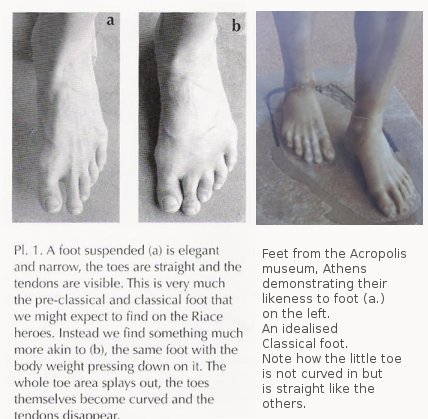

Figure 1
The bottom of the foot of Riace B. The sole is complete but for the piece cut out of the wax before casting (now filled with modern plaster) in order to enable the clay core to be supported directly by the outer mould in the firing process. Note that the ball of the big toe and of the two toes adjacent to it are flattened by the weight of the live model's body pressing the foot onto the plaster bed on which the model was standing during the mould-taking process. Note also that the sole shows all the idiosyncrasies of a human foot-sole, and that the little toe is folded in. These details clearly reproduce a 'live' footprint as preserved by a plaster mould. (Photo: Laboratoio di Fisca, Roberto Ciabattoni).

Figure 2
The bottom of the foot of a comparable modern bronze statue cast from a clay model. There is no sole, only the rim of bronze terminating the sides of the foot as it would be visible from above, the reason being that a sculptor making a clay model for casting in bronze cannot model the underside of a foot that is standing on the ground. Nor would he have any reason for doing so, since it would not be seen. (Photo: Nigel Konstam)

Figure 3
The bottom of the right foot of the classicising bronze kouros known as the 'Apollo of Piombino'. Paris, Louvre (Photo: Institut Mainini, Paris). Note that the bottom of the foot has naturalistic toes and a large cut-out for supporting the clay core directly by the outer mould during firing, the same figuration as in the bottom of the foot of Riace A and B (See Firgure 1. and Caption).
